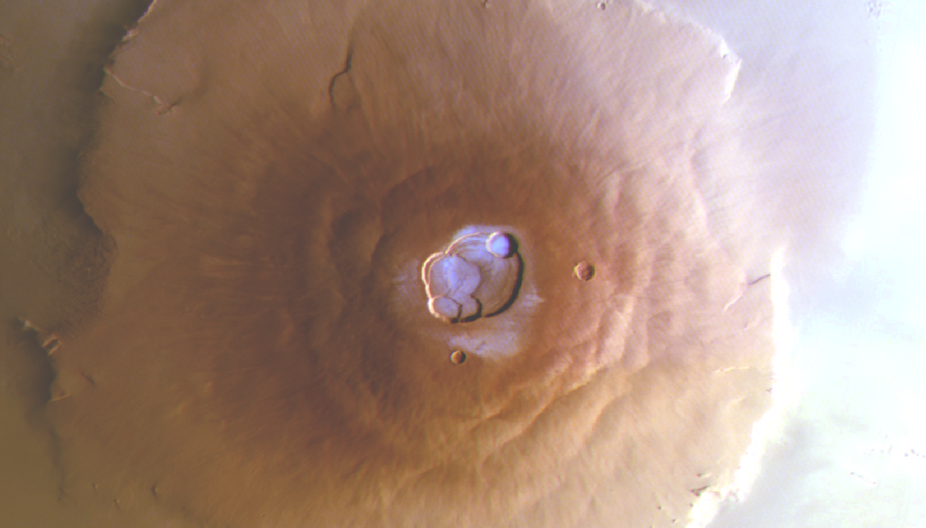Discovery: water frost at the summit of Martian volcanoes
Published by Adrien,
Source: The Conversation under Creative Commons license
Other Languages: FR, DE, ES, PT
Source: The Conversation under Creative Commons license
Other Languages: FR, DE, ES, PT
Follow us on Google News (click on ☆)
The formation of water frost is very common on Earth, especially in winter, due to the condensation of atmospheric water vapor. On Mars, there is an atmosphere about 100 times less dense than on Earth, which also contains water vapor. However, the Martian atmosphere contains 10,000 times less water vapor than Earth's atmosphere, making frost less likely.

Frost has been detected on Olympus Mons, the tallest volcano not only on Mars but in the entire solar system.
ESA/DLR/FU Berlin, Provided by the author
Today, the exchanges of water between the surface and the atmosphere are not well understood on the Red Planet. However, the formation of frost is an important indicator, useful for understanding the water cycle, and identifying key resources for potential future human exploration to constrain potential habitability. Indeed, water is a necessary resource for life but could also be used as rocket fuel.
Journey to the summit of Martian volcanoes
Our new study, published today in Nature Geoscience, reports the existence of significant transient morning frost deposits at the summit of volcanoes in a region called Tharsis (i.e., Olympus, Arsia, and Ascraeus Montes, and Ceraunius Tholus) using high-resolution color images from the Exomars Trace Gas Orbiter (TGO) of the European Space Agency (ESA). This discovery was confirmed using independent observations made by the ESA's Mars Express probe and the NOMAD spectrometer aboard the TGO.
Furthermore, numerical simulations of the Martian climate show that the surface temperatures of these volcanoes are compatible with the presence of frozen water. Indeed, results show that morning frost deposits are correlated with the coldest Martian seasons. Yes, Mars has seasons like Earth, but with much lower temperatures, ranging from -202°F to -22°F (-130°C to -30°C) on the Martian summits. Additionally, equatorial volcanoes receive intense solar insolation quickly, explaining the rapid disappearance of frost in the morning.

CaSSIS image of a bright, slightly blue area due to frost in the volcanic crater (caldera) of Olympus Mons.
ESA/TGO/CaSSIS, Provided by the author
It all begins with the observation of brighter and slightly blue areas on the summit of Martian volcanoes by the CaSSIS camera. After an investigation campaign lasting several months, these strange bright areas seem to be present only in observations taken early in the morning and during the cold seasons of Mars. The HRSC camera confirmed these observations, but the origin of this phenomenon remained to be found.
On Mars, there are two types of volatile compounds: water (H2O) and carbon dioxide (CO2). Both compounds can easily change phase between gas and solid under Martian conditions. Unfortunately, in solid form, they both appear white or bright in the visible light range (observable by our eyes) of the CaSSIS instrument. It is therefore difficult to distinguish them with a simple image. A real investigative effort was required to distinguish these objects. Two major types of arguments were established: one based on spectroscopy and the other on numerical simulations of the micro-climate of Martian volcanoes.
By decomposing the colors or wavelengths of light from the surface, it is possible to distinguish H2O and CO2. This is the technique of spectroscopy, facilitated by the NOMAD instrument. We attempted to identify these compounds in measurements taken under extreme conditions, early in the morning, with little sunlight. Since the instrument is optimized to observe the sun directly, these observations are challenging and very noisy. The results did not show any CO2 signature and suggested a possible water signature.
However, if CO2 is present in a thin layer, no spectral signature is expected. This argument is therefore not definitive. The Belgian team members then conducted a numerical simulation of the micro-climate of Martian volcanoes. This is the same type of tool used for weather forecasting on Earth, adapted here for Mars. The simulations concluded that at the time of image acquisitions showing the bright areas, conditions were favorable for water condensation but not for CO2. These two combined pieces of evidence favor the hypothesis of water frost.
A thin layer of frost
Thanks to information from various instruments, we estimated the thickness of this frost layer. It is a very thin layer, about 10 microns thick (1/100th of a millimeter). This amount of frost is limited by the amount of available atmospheric water vapor on Mars, which is in the range of microns-precipitable. For comparison, on Earth, the water amount is in the range of centimeters-precipitable, 10,000 times more!
Since condensation must start a few hours before sunrise, atmospheric circulation has allowed nearby atmospheric water to accumulate. Given the surface covered by the frost, the total amount of water is around 60 Olympic swimming pools. If we could harvest it, it could meet astronauts' water needs for several years, but on the scale of the planet Mars, this amount remains very small. The estimated amount of water available on Mars, mainly in the form of ice in the polar caps, is about 1 trillion Olympic pools, knowing that Earth has about 100 times more water than Mars.
This discovery of frost on the highest peaks of the solar system will refine our understanding of the current water cycle on Mars. This will enable better weather prediction on Mars for future exploration, as well as a better understanding of Mars' past climate and its potential habitability.